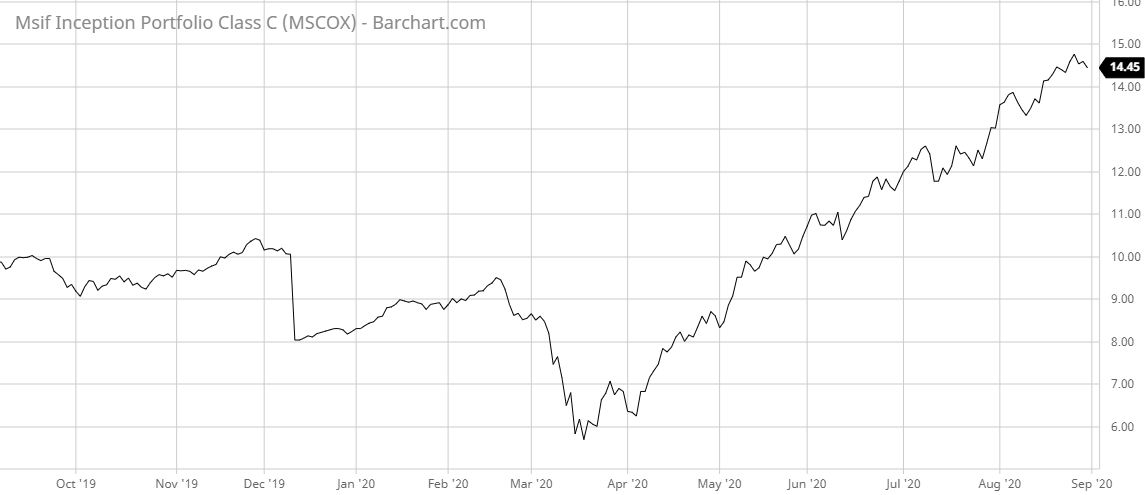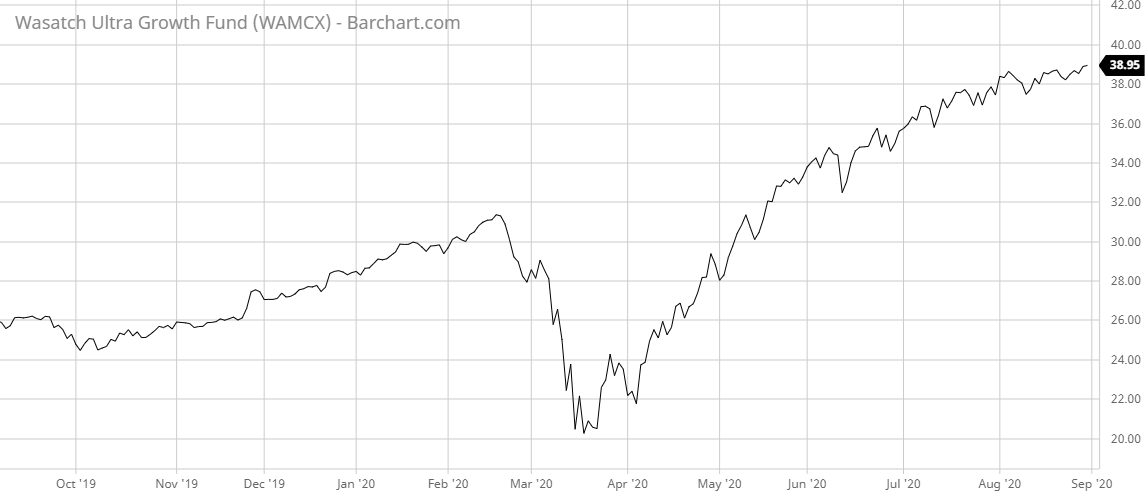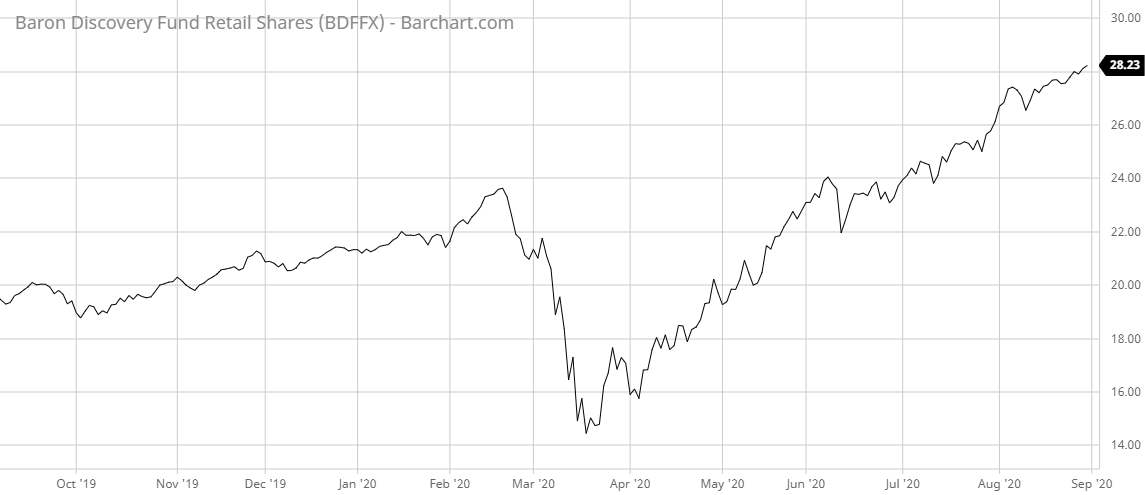First, we select the top trending category from more than 200 categories listed on MutualFunds.com based on the percentage increase in monthly viewership. From the top trending category, we select the top three funds with the highest one-year trailing total returns. To ensure the quality and staying power of funds, we only look at those mutual funds with a minimum of $250 million in assets and a track record of at least three years. We also remove those mutual funds that are closed to new investors and are not available for investment outside registered accounts such as retirement or 529 accounts.
In this week’s edition, we analyze the top three small-cap equity funds. These funds specifically target companies with a market capitalization typically between $300 million and $2.5 billion. Market sector weights are generally diverse with portfolio managers selecting stocks based on very specific criteria such as expected future EPS growth.
In the first week of July, the U.S.-focused small-cap equity category was the top trending article. We covered the top three funds at that time here. With the stock market recovering from the COVID-19 pandemic, investors are looking for new opportunities with fast-growing and aggressive companies, making these funds extremely popular right now.
Our breakdown of each fund includes key aspects such as 1-year performance, fund expenses, investment style and management teams to give you an overview of how these funds hold up against their peers.
Be sure to check out the Small-Cap Equity Funds page to find out more about the other funds in this category as well.
Trending Funds
1. Morgan Stanley Inception Portfolio Fund (MSCOX)
Taking the number one spot on our list this week is the inception portfolio fund (MSCOX) by Morgan Stanley. It comes with an astounding trailing 1-year performance of 81.58%. On an annualized basis, however, the fund currently shows an estimated 10-year return of 8.10%. The fund comes with a high gross expense ratio of 2.75% as well, making it the most expensive fund for investors to own on our list.
The investment strategy of the fund is to identify small-cap equities with a market capitalization range that is currently between $11.2 million and $7.3 billion that are part of the Russell 2000 Growth Index. Management uses a bottom-up stock selection methodology to find companies with competitive advantages, strong financial records and higher-than-average rates of return on capital. The fund is benchmarked to the Russell 2000 Growth Index as well.
Dennis Lynch, head of the Counterpoint Global team at Morgan Stanley Investment Management, is the portfolio manager of the fund and has been managing the fund since 1999. He is supported by others like David Cohen, Sandeep (Sam) G. Chainani, CFA, and Alexander Norton.
The top five sector weights in the fund’s portfolio are information technology (27.68%), consumer discretionary (20.82%), health care (20.31%), real estate (9.80%) and communication services (9.37%). The top five stock holdings include Overstock.com (8.70%), Fastly (8.57%), Stitch Fix (5.06%), NanoString Technologies (4.87%) and FirstService Corp (4.79%).
Learn more about different Portfolio Management concepts here.

Next on our list is Wasatch’s Ultra Growth Fund (WAMCX). It generated an impressive trailing 1-year total return of 56.35%. The relatively low gross expense ratio of 1.25% makes it cheaper than other similar mutual fund types.
The investment strategy of the fund is to select companies with a market cap of less than $5 billion and have a higher-than-average expected growth rate. It may include up to 30% of its assets in foreign companies from both developed and emerging markets. The portfolio is benchmarked to the Russell 2000 Growth Index.
The portfolio manager of the fund is John Malooly, CFA, who has been managing the fund since January 2012.
The top five sector weights in the portfolio are currently health care (34.4%), information technology (24.2%), consumer discretionary (13.9%), industrials (7.3%) and consumer staples (4.9%). The fund’s portfolio currently contains 84 holdings with the top five listed as Grocery Outlet Holding Corp (2.8%), Silk Road Medical (2.7%), Five Below (2.4%), Kornit Digital (2.2%) and Freshpet (2.2%).
Find out the funds suitable for your portfolio by using our free Screener.

The final mutual fund on our list is Baron’s Discovery Fund (BDFFX). It delivered a solid trailing 1-year total return of 48.58%. The gross expense ratio of 1.36% is only slightly higher than the Wasatch fund and still places it on the lower end for fees compared to its peers.
The investment strategy of the fund is to select stocks from the Russell 2000 Growth Index with market caps of $2.5 billion or less. Management seeks companies that have both a higher-than-average EPS growth rate and a competitive market advantage. It uses the Russell 2000 Growth Index as its portfolio benchmark.
Since its inception in September 2013, the fund has been managed by Laird Bieger, vice president, portfolio manager at Baron, and Randolph Gwirtzman, vice president portfolio manager at Baron.
The top five sector weights are health care (29.56%), technology (25.42%), industrials (18.87%), financial services (7.81%) and consumer cyclical (7.35%). The top five holdings in the fund’s portfolio are currently listed as Kinsale Capital Group (3.97%), Floor & Decor Holdings (2.99%), SiteOne Landscape Supply (2.94%), Endava PLC ADR (2.90%) and CareDx (2.71%).
Want to know more about portfolio rebalancing? Click here.

The Bottom Line
Our expert analysis of the top three will give you insight so you know what the best Small-Cap Equity Equity Fund is that fits your portfolio needs. And don’t forget to sign-up for our free newsletter to get the latest insights on mutual funds!
Make sure to visit our News section to catch up with the latest news about mutual fund performance.
Note: Data as of August 27, 2020

